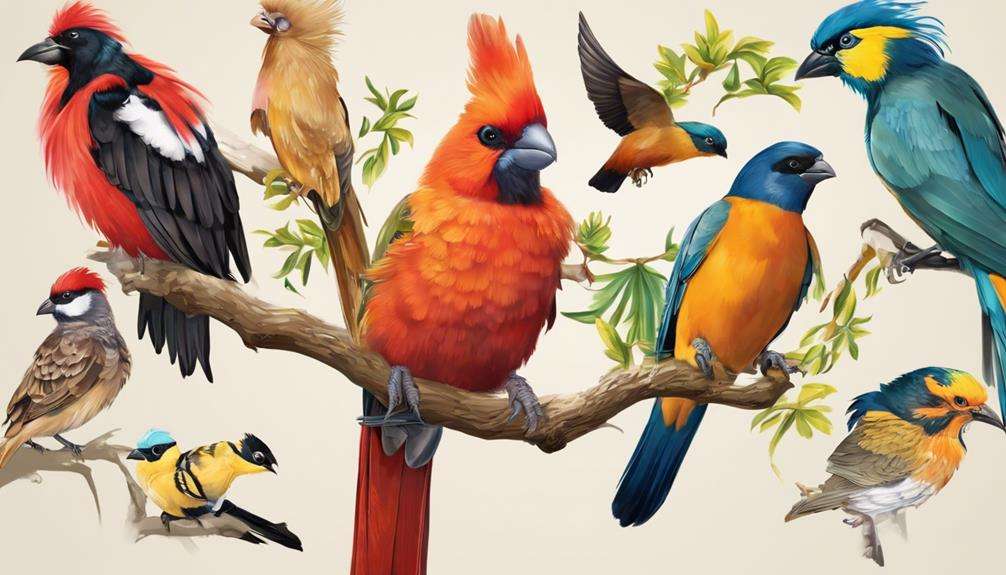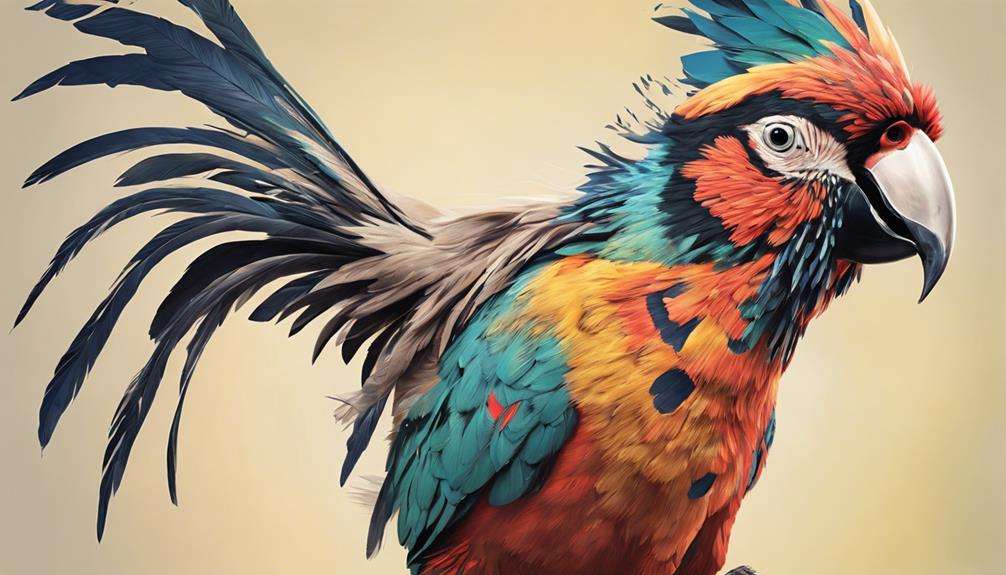As an avian enthusiast, you might be intrigued by the Vogelkop Superb Bird-of-Paradise, known for its dazzling plumage and intricate courtship displays. However, there are nine more lesser-known bird species awaiting your discovery, each with its own unique characteristics and habitats.
From the Rufous-headed Hornbill to the Blue-eyed Ground-Dove, these birds offer a glimpse into the remarkable diversity of avian life. But what makes them truly fascinating? Stay tuned to uncover the enthralling traits that set these feathered creatures apart and continue your exploration of the avian world.
Key Takeaways
- The Rufous-headed Hornbill and Imperial Amazon Parrot face critical endangerment.
- Unique characteristics like elaborate mating rituals define the Vogelkop Superb Bird-of-Paradise.
- Conservation efforts are crucial to protect endangered species like the South Philippine Dwarf Kingfisher.
- The Blue-eyed Ground-Dove serves as an indicator species for the threatened Cerrado ecosystem.
Vogelkop Superb Bird-of-Paradise
The Vogelkop Superb Bird-of-Paradise, also known as the Vogelkop Lophorina, captivates with its exclusive habitat on Vogelkop Island and its unique mating behaviors. This species is distinguished by its elaborate mating ritual, where the male bird performs an intricate dance to attract a mate.
Vogelkop Island serves as the primary home for these birds, showcasing their habitat specificity and the importance of preserving this environment. Conservation efforts are essential for the continued survival of the Vogelkop Superb Bird-of-Paradise, given its limited range and specialized behaviors.
Recognized as its distinct species in 2018, this bird isn't currently endangered, but proactive measures are crucial to guarantee its long-term sustainability. By monitoring populations and safeguarding their habitat, researchers and conservationists play a crucial role in protecting the Vogelkop Superb Bird-of-Paradise for future generations to admire and study.
Rufous-headed Hornbill
Why is the Rufous-headed Hornbill a critically endangered species in the Philippines? The Rufous-headed Hornbill, also known as the Philippine hornbill, faces the threat of extinction primarily due to habitat loss. The destruction of its rainforest habitats on the Philippine islands where it resides has led to a significant decline in its population. As a critically endangered species, urgent conservation efforts are necessary to guarantee the survival of this unique bird.
With its distinctive rufous head and alluring appearance, the Rufous-headed Hornbill is a rare find for avian enthusiasts. However, the dwindling numbers of this species emphasize the importance of implementing conservation measures promptly. Protecting the remaining habitats of the Rufous-headed Hornbill and addressing the root causes of habitat loss are essential steps in preserving this bird from extinction.
Conservation initiatives aimed at safeguarding the Philippine hornbill not only benefit this particular species but also contribute to the preservation of biodiversity in the region. By raising awareness about the plight of the Rufous-headed Hornbill and taking concrete actions to protect its habitat, we can make a difference in securing the future of this critically endangered bird.
Kakapo
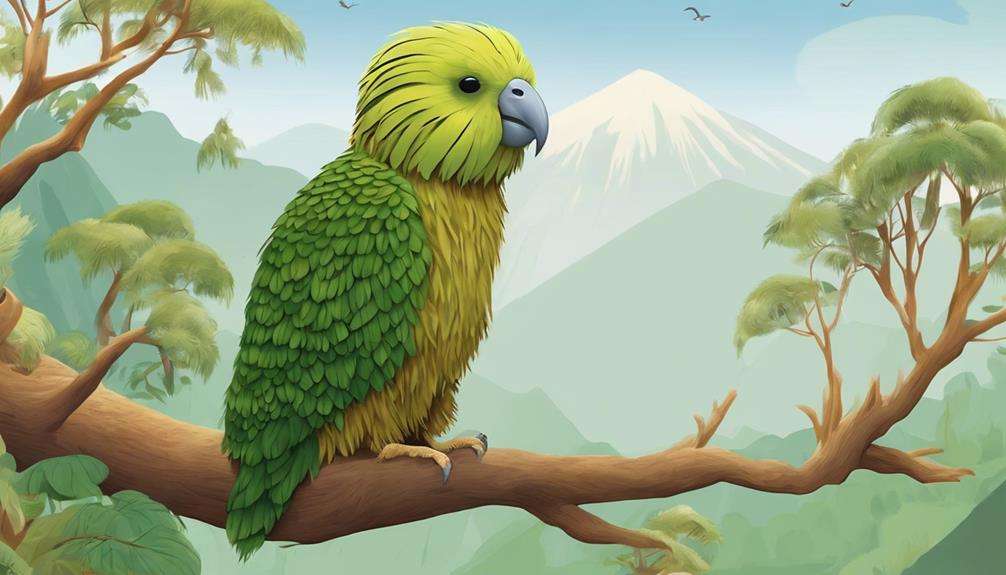
Facing a critical status with only around 200 known individuals, the flightless Kakapo parrot, endemic to New Zealand, is a species of great concern for conservation efforts. These critically endangered, nocturnal birds have unique traits that set them apart. Kakapos are renowned for their inability to fly, instead using strong legs for ground movement and climbing.
Their nocturnal nature means they're most active at night, displaying exceptional adaptations for this lifestyle, such as superb camouflage and excellent night vision. Kakapos also have distinctive mating behaviors, with males attracting females through loud calls and a unique booming sound.
Conservation initiatives are essential for the survival of the Kakapo, as invasive species like rats and feral cats have decimated their populations. Efforts to protect and increase the Kakapo population involve intensive monitoring, habitat restoration, and predator control. The future of these fascinating birds relies heavily on dedicated conservation work and raising awareness about their plight.
Imperial Amazon Parrot
The Imperial Amazon Parrot, scientifically known as Amazona imperialis, possesses rare plumage patterns that aid in its camouflage within the lush forests of Dominica.
Its unique vocalizations, ranging from melodious calls to sharp squawks, serve various purposes in communication and territorial defense.
Conservation efforts for this critically imperative species are pivotal to preserving its stunning beauty and distinctive behaviors in the wild.
Rare Plumage Patterns
With its astonishing plumage patterns carefully crafted for camouflage, the critically endangered Imperial Amazon Parrot captivates observers with its visual splendor. This species, found only in Dominica with a dwindling population of 50 adults, boasts sensational plumage that aids it in blending seamlessly into its lush forest habitat.
The vibrant colors and intricate patterns of its feathers not only enhance its beauty but also serve a vital survival function by making it less visible to predators. Unfortunately, habitat loss and the destructive impact of Hurricane Maria have placed immense pressure on the already fragile population of these remarkable birds.
Urgent conservation efforts are imperative to safeguard the Imperial Amazon Parrot from the brink of extinction and preserve its rare and unique presence in the avian world.
Unique Vocalizations
Crafting an intricate symphony of whistles, squawks, and mimicry, the Imperial Amazon Parrot showcases its unique vocalizations as a vital aspect of its communication repertoire. These vocalizations play a significant role in the parrot's daily interactions, enabling them to communicate within their flock and attract potential mates during the breeding season.
With a wide vocal range at their disposal, Imperial Amazon Parrots can express a variety of emotions and establish their territory in the wild. Each parrot has distinctive vocal patterns that help identify individuals within the species. Studying these vocalizations provides valuable insights into the behavior, social dynamics, and overall well-being of these magnificent birds in their natural habitat.
The Imperial Amazon Parrot's vocalizations aren't just sounds but a complex language that shapes their interactions and survival strategies.
Cebu Flowerpecker
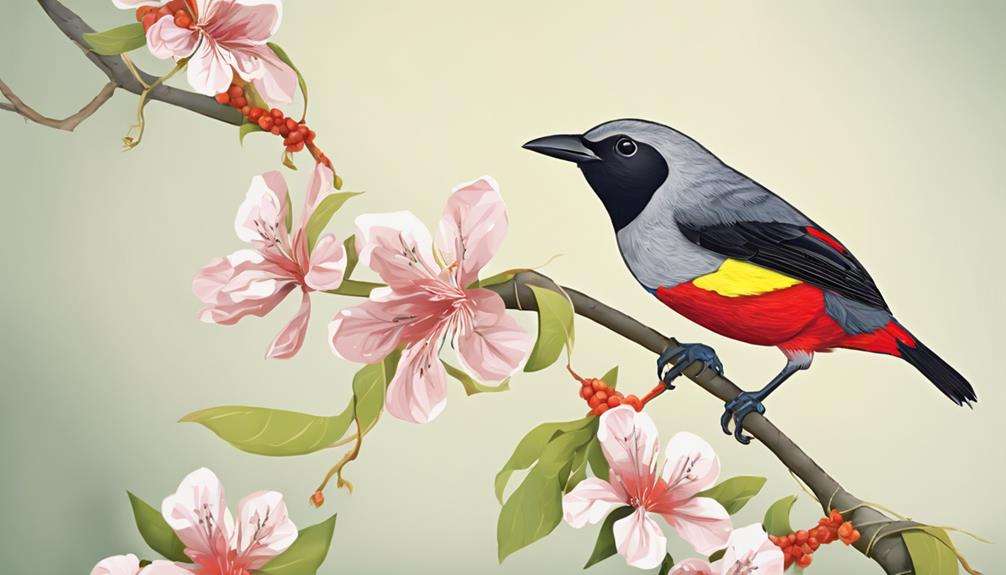
Endemic to Cebu Island in the Philippines, the critically endangered Cebu Flowerpecker is a tiny bird with unique coloration and remarkable small size. Once believed to be extinct, this species now teeters on the edge of survival, with only an estimated 85 to 105 individuals remaining. The Cebu Flowerpecker's precarious status is primarily a result of habitat loss and fragmentation, highlighting the urgent need for conservation efforts.
Measuring around 3.5 inches in length, this diminutive bird displays a vibrant combination of colors, with a striking mix of green, yellow, and black hues adorning its plumage. Despite its small size, the Cebu Flowerpecker plays an important role in the ecosystem of Cebu Island. Its presence helps in pollination and seed dispersal, contributing to the biodiversity of the region.
To ensure the continued existence of the Cebu Flowerpecker, concerted actions must be taken to protect its remaining habitat and address the factors threatening its survival. Conservation initiatives aimed at safeguarding this species are imperative to prevent its disappearance from the natural world.
New Zealand Rock Wren
The New Zealand Rock Wren exhibits unique nesting behavior by constructing dome-shaped nests from twigs, grass, and moss, providing protection amidst rocky landscapes.
These wrens are known for their distinctive song patterns, using melodious calls to establish territories and communicate with other individuals.
Classified as a near-threatened species, the New Zealand Rock Wren requires conservation efforts to safeguard its survival due to its limited distribution and vulnerability to introduced predators.
Unique Nesting Behavior
Nestled beneath the protective cover of large rocks or within rugged rock crevices, the New Zealand Rock Wren showcases a remarkable nesting behavior that reflects its alpine habitat adaptation. These unique birds meticulously construct dome-shaped nests using moss, lichen, and twigs, blending them seamlessly with the rocky surroundings for camouflage and protection.
The New Zealand Rock Wren's nesting behavior is a proof of their survival skills in harsh alpine environments. Surprisingly, only female Rock Wrens incubate the eggs, while males take on the responsibility of providing food for the nest. This division of labor guarantees the best chances of reproductive success for this captivating species, the only true alpine bird in New Zealand.
Distinctive Song Patterns
Adapting to its alpine habitat, the New Zealand Rock Wren showcases distinctive song patterns that are essential for communication and social interaction within its species. These song patterns are unique to the Rock Wren, with male birds producing intricate melodies of trills and whistles.
In contrast, female Rock Wrens vocalize with simpler and softer notes. The Rock Wrens utilize their songs for various purposes, including communicating within their social groups and defining territorial boundaries.
The elaborate song patterns of the New Zealand Rock Wren are critical for mate attraction and establishing strong pair bonds. Through these melodious tunes, these birds navigate the rugged terrain of their habitat, ensuring effective communication and fostering relationships important for their survival.
Endangered Conservation Status
Endangered due to habitat loss and introduced predators, the New Zealand Rock Wren faces a critical population decline, with less than 5,000 mature individuals estimated to remain. Classified as endangered by the IUCN Red List, this endemic bird species of New Zealand, specifically found in the South Island's alpine regions, is under threat.
Conservation efforts are pivotal to protect and preserve the New Zealand Rock Wren population. Habitat restoration projects, predator control measures, and monitoring initiatives are being implemented to support the recovery of this unique bird species.
With dedicated conservation actions and public awareness, there's hope to reverse the declining trend and ensure the survival of the New Zealand Rock Wren for future generations.
Golden Pheasant
With its striking colors and unique features, what makes the Golden Pheasant a visually enthralling bird species?
The Golden Pheasant, also known as the Chinese Pheasant, is renowned for its beautiful and colorful appearance. The male Golden Pheasant boasts vibrant plumage, characterized by a golden crest, red head to neck, dark wings, and a long barred tail. In contrast, the females exhibit a less flamboyant appearance with pale and brown feathers.
Weighing between 110-160 grams, this species is the smallest toucan breed and can be found nesting in tall trees near streams or clearings from February to June. Their diet consists of insects, fruit, seeds, berries, and nectar, contributing to their colorful and unique nature.
Avian enthusiasts worldwide are captivated by the Golden Pheasant's stunning beauty, making it a sought-after bird species for observation and admiration.
South Philippine Dwarf Kingfisher
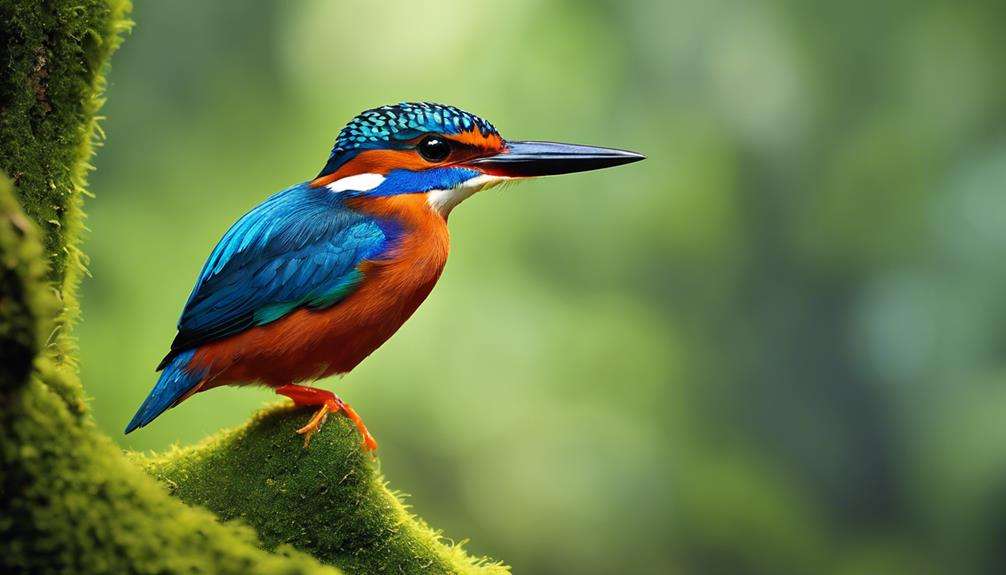
The South Philippine Dwarf Kingfisher, measuring around 13 cm in length, is endemic to the southern part of Mindanao island in the Philippines.
This species is renowned for its vibrant plumage, showcasing a striking combination of blue, green, and rufous colors.
Known to primarily feed on insects, small fish, and aquatic invertebrates, the South Philippine Dwarf Kingfisher faces conservation challenges due to habitat loss and fragmentation.
Size and Habitat
Measuring approximately 10 cm in length, the South Philippine Dwarf Kingfisher is renowned for its diminutive size among kingfisher species. Endemic to the Philippines, this small bird is primarily found in the southern regions of the country.
It inhabits diverse environments such as lowland forests, secondary growth forests, and forest edges, where dense vegetation provides cover for hunting and nesting. The species' small size allows it to navigate efficiently through the intricate foliage of its habitat in search of insects and small invertebrates.
However, due to habitat loss and fragmentation, the South Philippine Dwarf Kingfisher is classified as endangered, emphasizing the important need for conservation efforts to protect its forested homes in the Philippines.
Unique Coloration
Renowned for its diminutive size among kingfisher species, the South Philippine Dwarf Kingfisher mesmerizes observers with its vibrant hues of purple, blue, and green adorning its feathers. This bird boasts a striking color palette, featuring an iridescent blue back that contrasts beautifully with its bright orange underparts.
The intricate patterns and vivid colors of the South Philippine Dwarf Kingfisher make it a rare and visually enchanting sight in its natural habitat. These colors not only serve as camouflage in the forest but also play a vital role in courtship rituals.
Birdwatchers and wildlife photographers are drawn to this kingfisher species for its unique and vibrant coloration, adding to its charm and allure in the avian world.
Feeding Behavior
Demonstrate how the South Philippine Dwarf Kingfisher's feeding behavior showcases its adept hunting skills and energy-efficient foraging techniques.
This bird sustains itself primarily on insects and small invertebrates, using a strategic approach to hunting. By perching quietly and making short, rapid flights to catch its prey, the South Philippine Dwarf Kingfisher exhibits precision and agility in capturing its food.
This feeding behavior is important for maintaining the bird's energy levels, ensuring its survival in its habitat. With a sharp beak, it adeptly snatches insects while perched amidst the dense foliage where it resides.
The South Philippine Dwarf Kingfisher's feeding habits play an important role in the delicate balance of the ecosystem it inhabits, showcasing its importance in the local food chain.
Madagascar Pochard
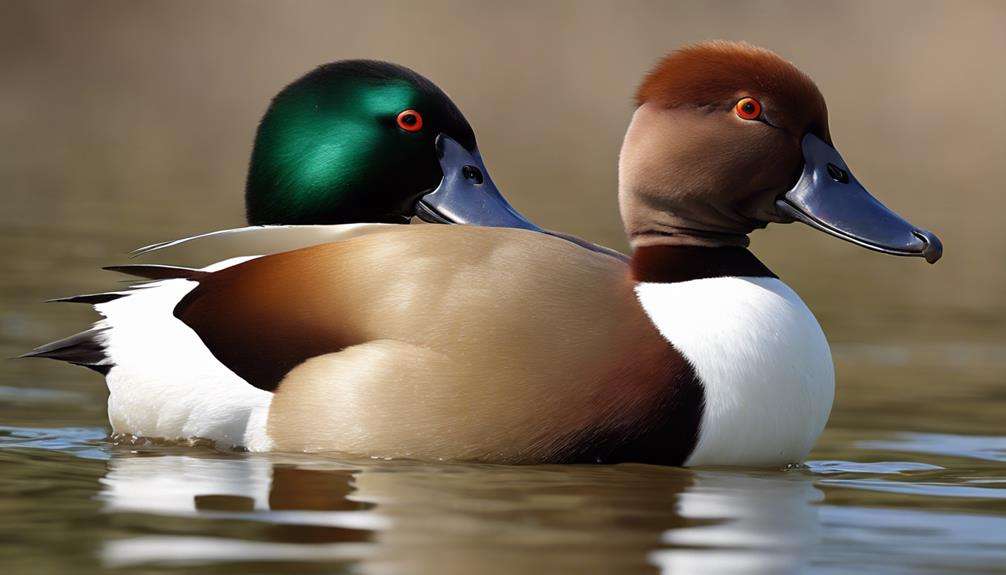
The Madagascar Pochard, a critically endangered waterfowl species found in the wetlands of Madagascar, was believed to be extinct until its rediscovery in 2006. This unique bird, the sole species in its genus, measures between 16.5 and 22 inches in length. Its habitat in the wetlands of Madagascar is under threat primarily due to habitat loss. With an estimated population of only a few individuals, the Madagascar Pochard stands as a rare and remarkable waterfowl species deserving urgent attention for its conservation.
Conservation efforts play an important role in safeguarding the Madagascar Pochard from the brink of extinction. Given its critically endangered status, concerted actions are necessary to protect and restore its wetland habitats. Through these conservation initiatives, the hope is to increase the population of this species and guarantee its survival in the wild for generations to come. The rediscovery of the Madagascar Pochard serves as a poignant reminder of the importance of preserving our planet's biodiversity.
Blue-eyed Ground-Dove
Nestled exclusively within Brazil's Cerrado region, the Blue-eyed Ground-Dove captivates with its magenta head and striking sapphire blue eyes, making it a unique and endangered avian species. This bird's appearance is distinctive, with the male showcasing vibrant colors while the female is paler in comparison. Unfortunately, habitat loss has critically endangered the Blue-eyed Ground-Dove species, threatening its existence.
The Blue-eyed Ground-Dove's beauty is matched by its mysterious nature. Despite its striking features, little is known about its breeding habits and diet. This lack of information adds to the urgency of conservation efforts aimed at preserving this rare and enchanting bird.
The Cerrado region, with its unique characteristics and diverse wildlife, serves as the sole habitat for the Blue-eyed Ground-Dove. Protecting this habitat is essential for the survival of this species and the preservation of Brazil's rich avian biodiversity. Efforts to combat habitat loss and raise awareness about the plight of the Blue-eyed Ground-Dove are vital to ensuring a future where this mesmerizing bird continues to grace the skies of the Cerrado.
Frequently Asked Questions
What Is the Number 1 Rarest Bird in the World?
The number 1 rarest bird in the world is the Spix's Macaw. Rarest bird sightings of this critically endangered species spark conservation efforts. Birding adventures seek to support efforts to save these majestic birds from extinction.
What Is the Coolest Bird of Prey?
When thinking of the coolest bird of prey, the Gyrfalcon stands out with its Arctic elegance. Glide through icy skies and marvel at its majestic white plumage. Witness a master of the hunt in action.
What Is the Funniest Looking Bird?
If you're looking for the funniest looking bird, the Kakapo stands out. With its silly plumage, quirky behavior like booming calls, and odd mating rituals, this flightless parrot is a true comedic character in the avian world.
What's the Most Unique Bird?
When seeking the most unique bird, consider the Vogelkop Superb Bird-of-Paradise. Its unusual behaviors, ecological adaptations, and distinctive vocalizations captivate observers. Witnessing its courtship dance is like seeing a rare gem sparkle.
Conclusion
You've just scratched the surface of the fascinating world of lesser-known bird species.
Remember, 'The early bird catches the worm,' so keep exploring and discovering these unique avian wonders.
Happy birdwatching!



